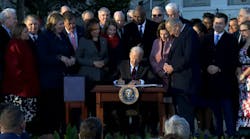Policy with bipartisan support is hard to find these days. Luckily, one of them involves the laudable effort to have more U.S.-made products used in federally funded contracts, such as public works and infrastructure projects. For these efforts to thrive and achieve a balanced Buy America policy, the government must reduce bureaucratic complexity, ensure greater transparency and tackle other problems that impede achieving the goals of domestic preference policies. Striking the right balance for Buy America requires a careful consideration of various factors such as economic benefits, job creation, exemptions and waivers and international trade obligations.
Domestic preference laws date back to 1933, though there were earlier laws at the state and local levels that encouraged domestic sourcing. Congress and President Herbert Hoover enacted the Buy American Act during the depths of the Great Depression as part of the National Industrial Recovery Act, creating a preference for U.S.-made products in its procurement of goods and services. Over time, subsequent laws expanded this effort.
In 1978, the Buy American Act was included as part of the Surface Transportation Assistance Act, which extended domestic-preference rules to federally financed transportation projects, such as airports, highways and public transit systems. Today, the Build America, Buy America Act, enacted as part of the Infrastructure Investment and Jobs Act, requires all federal agencies to ensure no federal financial assistance for “infrastructure” projects be provided “unless all of the iron, steel, manufactured products and construction materials used in the project are produced in the United States.”
These laws became more urgent—but also more complicated—as they were applied to new initiatives. These include President Joe Biden’s 2021 Executive Order on “Ensuring the Future Is Made in All of America by All of America’s Workers” and the Inflation Reduction Act, which includes the Clean Vehicle Credit (an electric vehicle tax incentive under IRS section 30D with battery sourcing requirements).
Each statute is unique and enacted with different requirements and policy goals in mind. The overarching goal, however, is the same: To boost domestic manufacturing and supply chains while increasing U.S. jobs and promoting economic development nationwide. But how does this happen effectively and efficiently?
The Build America, Buy America Act applies “Buy America” to all federally funded infrastructure and public works projects. Though simple in purpose, its requirements can vary depending on the program or project involved. This makes it harder for contractors to navigate the various rules and regulations, which, of course, are meant to minimize waste and misuse.
The Office of Management and Budget—and specifically its Made in America Office – has made progress in implementing President Biden’s January 2021 Executive Order and requirements under the Build America, Buy America Act and has been a strong tip of the spear on domestic preference policy efforts. A remaining core challenge involves agencies determining how to apply domestic-preference guidance to their infrastructure programs and processes.
Critics of Buy America policy argue it increases costs and reduces efficiency. However, these concerns can be addressed by ensuring the policy is implemented in a way that balances the economic benefits with the costs. For example, exemptions and waivers can be provided for goods and materials when strict adherence to the laws is not in the public interest, when the needed materials are not sufficiently available in the U.S. and when using U.S.-made materials would increase a project’s overall cost by more than 25 percent. Timely approval of these requests can help prevent project delays while ensuring the overall objectives of the law are still being met.
These aren’t easy matters. A phased transition, which includes a steady increase in domestic sourcing percentage thresholds to manage supply chains and materials acquisition, is critical to ensuring the viability of any domestic-preference policy.
Additionally, many industries have complex supply chains involving multiple tiers of suppliers and subcontractors. One of the main challenges here is ensuring all required materials and components are made in the U.S. This can be difficult, as many products are made with parts or materials sourced overseas, and it can be challenging to trace the origin of every component in a complex supply chain.
The government should reduce the administrative burden for Buy America compliance to help businesses—especially small- and medium-sized enterprises—compete for contracts without inordinate red tape. Inconsistent implementation of Buy America policies causes undue problems for manufacturers and project sponsors. They become unable to conduct long-term capital project planning, provide investors with peace of mind and predict how the government will treat project bids.
One of the most effective ways to reduce the administrative burden for Buy America compliance is to simplify the requirements. This can include providing clear definitions that apply across the federal government, reducing the number of required certifications and curtailing the amount of paperwork and other administrative tasks.
Greater transparency around the compliance process can also help reduce administrative burdens by enabling businesses to better understand the compliance requirements. Measures could include providing training materials and compliance best practices and ensuring compliance processes are clearly defined and communicated. Technical assistance, such as workshops, webinars or roundtable discussions, would also help.
Most Americans across the political spectrum support Buy America policies and rightly so. The policies support domestic production, enhance national security, certify quality and safety standards and support environmental interests. They promote fair competition by preventing the improper undercutting of domestic prices or distorting market competition.
Inconsistent implementation of Buy America policies, excessive administrative requirements and delays in approving appropriate waivers can hamper the program’s worthy goals. By continuing to address these challenges, the government can responsibly boost U.S. production and jobs.
-------------
Bennett E. Resnik is a senior vice president in the Critical Infrastructure Practice at Venn Strategies. The views and opinions expressed in this article are solely those of the author and do not necessarily reflect the views of Venn Strategies or its clients.

Bennett E. Resnik | Bennett Resnik, Senior Vice President, Venn Strategies
Bennett E. Resnik is a senior vice president in the Critical Infrastructure Practice at Venn Strategies, a full-service government relations and public affairs firm. Advocating before Congress and Federal agencies, Bennett advises clients on proposed federal regulations, federal funding and political strategy, advocating for favorable legislation and sensible regulations in the transportation and energy sectors.

